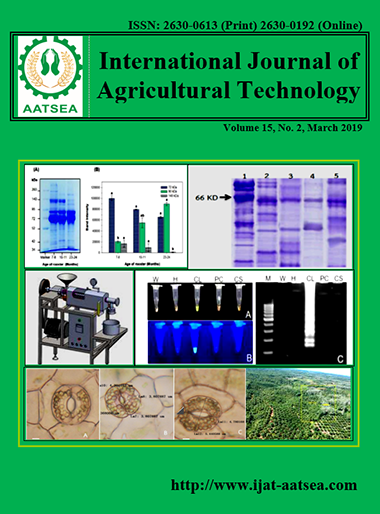Chemical properties, antioxidant activities and sensory evaluation of mango vinegar
Main Article Content
Abstract
This study was carried out to examine the chemical properties, antioxidant activities and sensory scores of mango vinegar produced from five mango cultivars, namely ‘Nam Dokmai’, ‘Kalon’, ‘Kaew’, ‘Chok Anan’ and ‘Maha Chanok’. Mango vinegars were produced via a two-stage (alcoholic and acetous) fermentation process. The initial soluble solid contents in the mango juice were adjusted to 22 ºBrix use refractometer before the fermentation. Alcoholic fermentation was conducted using Saccharomyces cerevisiae as the inoculant while Acetobacter pasteurianus was used for acetous fermentation. As observed for all samples during the alcoholic fermentation the levels of soluble solids decreased continuously and the levels of alcohol were found to increase at the end of fermentation process. Notably, the wine produced from ‘Nam Dokmai’ cultivar exhibited the highest levels of alcohol (14.82%) and antioxidant activity (DPPH method) (80.21%). Similar results were observed for all samples during the acetous fermentation, in which the levels of alcohol dropped continuously and the levels of acetic acid were noted to elevate at the end of the fermentation process. The highest levels of acetic acid (6.96%) was detected in the vinegars produced from ‘Kalon’ cultivar while those produced form ‘Maha Chanok’ cultivar exhibited the highest levels of antioxidant activity (91%). Sensory evaluation based on the 9-point hedonic scales showed that the vinegars produced from ‘Kaew’ cultivar displayed the highest overall acceptability with an average score of 6.23, equivalent to the hedonic scale of 9, which indicated the slightly pleasant levels of the vinegar preference of the consumers.
Article Details

This work is licensed under a Creative Commons Attribution-NonCommercial-NoDerivatives 4.0 International License.
References
Brand-Williams, W., Cuvelier, M. E. and Berset, C. (1995). Use of a free radical method to evaluate antioxidant activity. LWT - Food Science and Technology. 28:25-30.
Budak, N. H., Aykin, E., Seydim, A. C., Greene, A. K. and Guzel-Seydim, Z. B. (2014). Functional properties of vinegar. Journal of Food Science. 79:R757-R764.
Cardello, A. V. (2017). Hedonic scaling: assumptions, contexts and frames of reference. Current Opinion in Food Science. 15:14-21.
Chen, D. and Liu, S. Q. (2016). Transformation of chemical constituents of lychee wine by simultaneous alcoholic and malolactic fermentations. Food Chemistry. 196:988-995.
Chen, Y., Huang, Y., Bai, Y., Fu, C., Zhou, M., Gao, B., Wang, C., Li, D., Hu, Y. and Xu, N. (2017). Effects of mixed cultures of Saccharomyces cerevisiae and Lactobacillus plantarum in alcoholic fermentation on the physicochemical and sensory properties of citrus vinegar. LWT - Food Science and Technology. 84:753-763.
Chun, J.-E., Baik, M. Y. and Kim, B. Y. (2014). Manufacture and quality evaluation of purple sweet potato Makgeolli vinegar using a 2-stage fermentation. Food Science and Biotechnology. 23:1145-1149.
Ghosh, P. R., Fawcett, D., Sharma, S. B. and Poinern, G. E. (2016). Progress towards sustainable utilisation and management of food wastes in the global economy. International journal of food science 2016, 22 pages. doi: 10.1155/2016/3563478.
Ho, C. W., Lazim, A. M., Fazry, S., Zaki, U. K. H. H. and Lim, S. J. (2017). Varieties, production, composition and health benefits of vinegars: a review. Food Chemistry. 221:1621-1630.
Jagtap, U. B., Waghmare, S. R., Lokhande, V. H., Suprasanna, P. and Bapat, V. A. (2011). Preparation and evaluation of antioxidant capacity of Jackfruit (Artocarpus heterophyllus Lam.) wine and its protective role against radiation induced DNA damage. Industrial Crops and Products. 34:1595-1601.
Johnston, C. S. and Gaas, C. A. (2006). Vinegar: medicinal uses and antiglycemic effect. Medscape General Medicine. 8:61-61.
Kim, Y., Lounds-Singleton, A. J. and Talcott, S. T. (2009). Antioxidant phytochemical and quality changes associated with hot water immersion treatment of mangoes (Mangifera indica L.). Food Chemistry. 115:989-993.
Li, T., Lo, Y. M. and Moon, B. (2014). Feasibility of using Hericium erinaceus as the substrate for vinegar fermentation. LWT - Food Science and Technology. 55:323-328.
Reddy, L. V. A. and Reddy, O. V. S. (2011). Effect of fermentation conditions on yeast growth and volatile composition of wine produced from mango (Mangifera indica L.) fruit juice. Food and Bioproducts Processing. 89:487-491.
Rymbai, H., Srivastav, M., Sharma, R. R. , Patel, C. R. and Singh, A. K. (2015). Bio-active compounds in mango (Mangifera indica L.) and their roles in human health and plant defence – a review. The Journal of Horticultural Science and Biotechnology. 88:367-379.
Santhiraseggaram, V., Razali, Z., George, D. S. and Somasundram, C. (2015). Comparison of UV-C treatment and thermal pasteurization on quality of Chokanan mango (Mangifera indica L.) juice. Food and Bioproducts Processing. 94:313-321.
Shahidi, F., McDonald, J., Chandrasekara, A. and Zhong, Y. (2008). Phytochemicals of foods, beverages and fruit vinegars: chemistry and health effects. Asia Pacific journal of clinical nutrition 17 Suppl 1. pp. 380-382.
Singleton, V. L., Orthofer, R. and Lamuela-Raventós, R. M. (1999). Analysis of total phenols and other oxidation substrates and antioxidants by means of Folin-Ciocalteu reagent. In: Methods Enzymol, vol. 299. Academic Press. pp. 152-178.
Solieri, L. and Giudici, P. (2009). Vinegars of the World, In: L. Solieri & P. Giudici (Eds.), Vinegars of the World. Springer Milan, Milano, Italia. pp. 1-16.
Stratil, P., Kubáň, V. and Fojtová, J. (2008). Comparison of the phenolic content and total antioxidant activity in wines as determined by spectrophotometric methods. Czech Journal of Food Sciences. 26:242-253.
Taniasuri, F., Lee, P. R. and Liu, S. Q. (2016). Induction of simultaneous and sequential malolactic fermentation in durian wine. International journal of food microbiology. 230:1-9.
Varakumar, S., Naresh, K. and Reddy, O. V. S. (2012). Preparation of mango (Mangifera indica L.) wine using a new yeast-mango-peel immobilised biocatalyst system. Czech Journal of Food Sciences. 30:557-566


